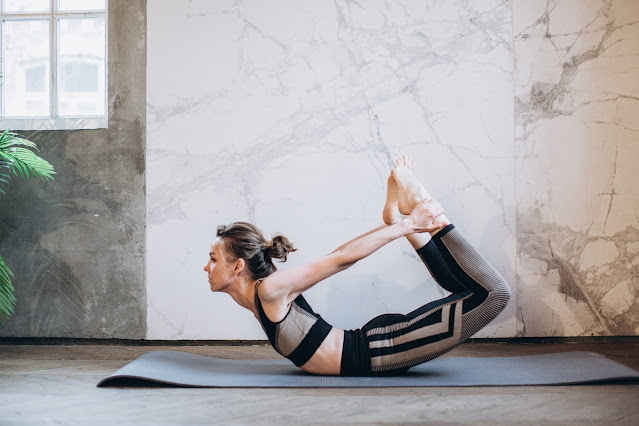Unlock Your Inner Strength: Mastering Dhanurasana for a Powerful Mind and Body
Introduction
A. Hook:- Begin the blog post with an attention-grabbing statement that highlights the transformative nature of practicing Dhanurasana. For example, "Discover the extraordinary power of Dhanurasana, the Bow Pose, as it unlocks your inner strength and empowers you both physically and mentally."
B. Briefly introduce the concept of unlocking inner strength through yoga, specifically focusing on how Dhanurasana contributes to cultivating a powerful mind and body. Highlight the keyword "dhanurasana" and its relevance throughout the blog post.
Understanding Dhanurasana
A. Explain the meaning and significance of Dhanurasana (Bow Pose), emphasizing its relevance in yoga practice. Discuss the origins of the pose and its representation of the bow shape, symbolizing strength and focus.
B. Highlight the physical benefits of Dhanurasana, such as increased flexibility, strengthened back muscles, improved posture, and enhanced digestion. Explain how the pose opens the chest and stimulates the abdominal organs.
C. Discuss the mental benefits of Dhanurasana, including its ability to reduce stress, relieve anxiety, enhance focus, and promote emotional well-being. Elaborate on how the backbend in Dhanurasana stimulates the nervous system and encourages positive energy flow.
D. Emphasize the mind-body connection that Dhanurasana fosters, explaining how the physical practice of the pose activates mental and emotional strength. Discuss the role of breath control and mindfulness during the pose.
Preparing for Dhanurasana
A. Provide warm-up exercises and stretches that specifically target the muscles and areas of the body involved in Dhanurasana. Include dynamic stretches for the shoulders, chest, hips, and thighs.
B. Recommend yoga sequences or poses that can help prepare the body for the demands of Dhanurasana. Explain how poses like Cat-Cow, Cobra, and Bridge can help open and strengthen the relevant muscle groups.
C. Share tips and precautions for beginners to approach Dhanurasana safely, ensuring proper alignment and gradual progression. Discuss the importance of listening to the body, using props if needed, and consulting with a yoga instructor.
Mastering Dhanurasana
A. Offer a step-by-step guide on how to perform Dhanurasana correctly, including the initial setup, movements, and proper breathing techniques. Emphasize the engagement of the legs, core, and back muscles.
B. Provide detailed guidance on achieving optimal alignment in the pose, discussing the position of the arms, shoulders, and gaze. Explain the importance of finding balance and avoiding excessive strain on the lower back.
C. Address common mistakes or challenges faced by practitioners and offer tips on how to overcome them, ensuring a safe and effective practice of Dhanurasana. Discuss modifications and variations for different body types and flexibility levels.
D. Include visual aids, such as images or diagrams, to illustrate the correct alignment and execution of Dhanurasana.
Unleashing Inner Strength
A. Explore the mental and emotional benefits of Dhanurasana, highlighting how the pose can help individuals tap into their inner strength and resilience. Discuss the release of tension and stored emotions during the backbend.
B. Discuss the connection between physical strength developed through Dhanurasana and the resulting mental fortitude. Explain how the pose builds self-confidence, determination, and the ability to face challenges with a resilient mindset.
C. Share inspiring stories and personal experiences of individuals who have found inner strength, confidence, or emotional healing through their consistent Dhanurasana practice. Include testimonials and quotes from yoga practitioners.
Integrating Dhanurasana into Your Routine
A. Provide practical tips on incorporating Dhanurasana into a regular yoga practice, such as recommended frequency and duration. Discuss the benefits of including Dhanurasana in a well-rounded yoga routine.
B. Suggest variations and progressions of Dhanurasana that allow practitioners to continually challenge themselves and deepen their practice. Explain how modifications like Half Bow or One-Legged Bow can be explored.
C. Emphasize the importance of consistency and dedication in order to experience the long-term physical and mental benefits of Dhanurasana. Discuss how to maintain motivation and overcome plateaus in the practice.
Conclusion
A. Summarize the key points discussed in the blog post, highlighting the transformative power of Dhanurasana for unlocking inner strength. Reinforce the significance of the mind-body connection and the holistic benefits of the pose.
B. Encourage readers to embrace Dhanurasana as a powerful tool for cultivating a strong mind and body. Urge them to explore the practice with curiosity and commitment.
C. Inspire readers to embark on their own journey of self-discovery and personal growth through the consistent practice of Dhanurasana. Encourage them to tap into their inner strength and unlock their true potential.
FAQs:
What does the term "Dhanurasana" mean?
Dhanurasana is a Sanskrit term that translates to "Bow Pose" in English. It is a yoga pose that resembles the shape of a bow.
Can Dhanurasana help with improving flexibility?
Yes, Dhanurasana is known for its ability to increase flexibility, particularly in the spine, shoulders, and hips. Regular practice can gradually enhance overall flexibility.
Is Dhanurasana suitable for beginners?
Dhanurasana can be challenging for beginners, but with proper guidance and modifications, it is accessible to practitioners of different levels. It is recommended to start with preparatory poses and gradually work towards mastering Dhanurasana.
How does Dhanurasana benefit the mind?
Dhanurasana has numerous mental benefits. It helps reduce stress, calms the mind, and promotes emotional well-being. The backbend in Dhanurasana stimulates the nervous system, releasing tension and improving focus.
Are there any precautions to consider while practicing Dhanurasana?
Yes, it is important to practice Dhanurasana with caution. Avoid excessive strain on the lower back and modify the pose if needed. It is advisable to learn the pose under the guidance of a qualified yoga instructor to ensure proper alignment and safety.
Can Dhanurasana help with back pain?
Yes, Dhanurasana can be beneficial for relieving mild to moderate back pain when performed correctly. The pose strengthens the back muscles, improves spinal alignment, and increases blood circulation, which can help alleviate discomfort.





Post a Comment